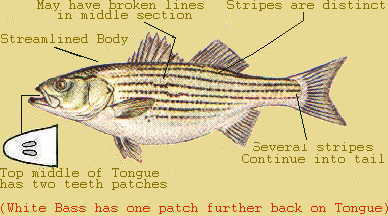

Statement: I am just a fisherman, not a fisheries biologist, or scientist. The information here is what I have gathered from observations on the water, researching any and all books, magazines, and website's I could find. The information may not be 100% accurate but is only meant to give you a good understanding of this my favorite species to fish for.
Nicknames: stripers, rocks, rockfish, linesides, greenhead, squidhead.
Description: The striped bass is olive green on back fading to silver sides with white belly, and has 6 to 8 unbroken black stripes. Dorsal fins are distinctly separate, unlike yellow bass, which are joined at the base. Second dorsal fin with 1 spine and 11 or 12 soft-rays, anal fin with 3 spines and 10 or 11 rays. Pelvic fins in large adults, white with anal fin edged in white. The second spine on the anal fin is about half the length of the third spine in striped bass, and about two-thirds the length of the third spine in white bass. Similarly, striped bass have two sharp points on each gill cover, and white bass have one. Lower jaw protrudes beyond upper jaw. Generally two patches of teeth on tongue, whereas white bass have one tooth patch. Tail is slightly forked.
Spawning: The Striped bass runs upriver to spawn in April and May. Spawning begins when water temperatures approach 60 degrees fahrenhiet. The female is generally accompanied by several males during spawning. Laying thier eggs in shallow water (less than 10ft) , the eggs must tumble in current for approximaly 48 to 72 hours before hatching. The eggs are slightly heavier than water and therefore require consistant current to hatch. The male reaches maturity and spawns in its third year. The female reaches maturity and spawns in its 4th year.
Size: May reach 10-12 inches in first year. 4yr. old fish approximatly 7-8lbs. Record largest fish 125lbs (saltwater).
Historically: A boom or bust spawner. Water conditions dictating the effectiveness of spawn. Long lived fish may live as long as twenty years. Normally fish over thirty pounds are female.
Feeding: Larvae feed on yolk sac for seven to eight days progressing to crustaceans. Adults primarily feed on other fish. Here in Western Kentucky I have found only gizzard shad, threadfin shad, and herring in the stomach
.